
Euphorbia granulata / حليبة
Euphorbia bombaiensis sensu Stewart Euphorbia granulata var. glabrata Boiss. Euphorbia turcomanica Boiss.
Halb, Libbeina, Harumdezen, Turerun, Helban
Halb, Libbeina, Harumdezen, Turerun
Euphorbiaceae
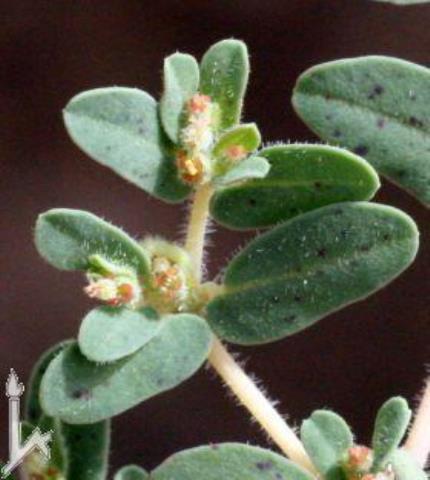
Aerial parts

Herbarium specimen
Ethnobotanical Characteristics
Description
A somewhat variable densely pubescent to almost glabrous much-branched prostrate annual or perennial herb with stems to 20 cm long. Petioles 0.5 mm long. Leaf-blades obovate-oblong, 1-8 x 0.5-5 mm, rounded or emarginate at the apex, obliquely rounded at the base, entire or almost thick and slightly fleshy, rugulose when dry, glaucous. Stipules subulate, 0.5 mm long. Cyathia axillary, solitary. Glands transversely ovate, yellowish or ochreous, sometimes reddish, with unequal, subentire white or pink appendages. Fruits trigonous, keels carinate, 1.1 x 1.1 mm, smooth, either pubescent all over or else on the keels only, with simple hairs. Seeds narrowly ovoid-cylindrical, quadrangular, 0.8 x 0.4 mm, irregularly foveolate-rugulose, pinkish grey (Jongbloed, 2003, Flora of Pakistan, Mandaville, 1990).
Habitat and Distribution
Sandy soil, along roadside. Found in Egypt, Palestine, Iraq, Saudi Arabia, Bahrain, Abu Dhabi, Aden, Iran, Pakistan (Baluchistan) and Afghanistan (Daoud, 1985).
Only at intermediate to Upper Mountain elevations among rocks on open slopes; found in Asimah, Ras Al Khaima (Western, 1989).
Part(s) Used
whole plant
Traditional and Medicinal Uses
The nomadic Touareg people of the Sahara use the latex internally as anthelmintic, and externally apply it to snakebites and scorpion stings. In Saudi Arabia the latex is taken as a purgative, anthelmintic and diuretic, as well as for its blood purifying properties (Schmelzer, 2008).
Pharmacognosy and Phytochemistry
Plant material studied
Dried leaf
General appearance
The leaf is oblong to oval in shape, very small (4-6 mm long, 2-3 mm broad). Its dorsal side is grayish-green while its ventral side is purple to violet. When dried, it slightly shrinks exposing its ventral side outwards and its dorsal side inwards. It is quite brittle, and most of the dried leaves are found broken.
Microscopic characteristics
A surface view of the leaf shows that the upper epidermis consists of polygonal cells bearing stomata-like structures while the lower one consists of sinuous cells bearing long warty uniseriate conical trichomes and that an intricate venation extends to the periphery alongside the margins. In sectional view the leaf exhibits a dorsiventral character. The upper epidermis is shown to consist of small oval cells that protrude out to form pyramidal extensions. It is underlain by a layer of palisade cells, which are slender and closely packed. These are underlain by few layers of oblong spongy mesophyll cells; those spongy cells surrounding the vascular tissues are quite characteristic in that they have similar sizes and are arranged in an orderly manner forming one layer. Other spongy cells contain yellowish brown matter. The xylem vessels are annularly thickened in general.
Dried small branches
General appearance
The branches are slender; less than 1 mm in width, dark green with a violet tint and it is brittle.
Microscopic characteristics
A cross-section through the stem shows that it is almost cylindrical in outline, and the epidermal cells that are rectangular or square in surface view are oval and protruding in half circles in section view. They bear long warty tapering uniseriate covering trichomes. The epidermis is underlain by about five layers of rounded parenchyma cells of the cortex, followed by few layers of compressed cortical parenchyma cells that surrounded the vascular tissues. The vascular tissues form a wide circle occupying a large zone that includes heavily lignified xylem tissues with annularly thickened vessels. The pith occupies the central zone, and it consists of cells of irregular shapes and thick walls, and usually, they separate from each other forming a large central lacuna or shape.
Powdered plant material
the material consists of the pounded whole plant. It is a grayish-brown heterogeneous coarse powder that contains whitish stem and root fragments. It has an odour reminiscent of dried straw and a stringent taste. Microscopically, the powder shows leaf fragments at different positions showing leaf surfaces or cross-sections exhibiting the characteristic intricate venation, the small oval cells of the upper epidermis, and margin cells that protrude to form pyramidal extensions, and the sinuous cells of the lower epidermis that bear warty uniseriate conical trichomes. Also shown are fragments of the characteristic leaf spongy mesophyll cells that surrounded the vascular tissues, forming a characteristic roseate-like structure. The powder also shows the epidermal cells of the stem and branches with their square or rectangular outlines on surface view besides long fragments of the grey vascular tissues. A floral fragment are occasionally observed.
Microscopical Studies
Parts studied
leaf and stem
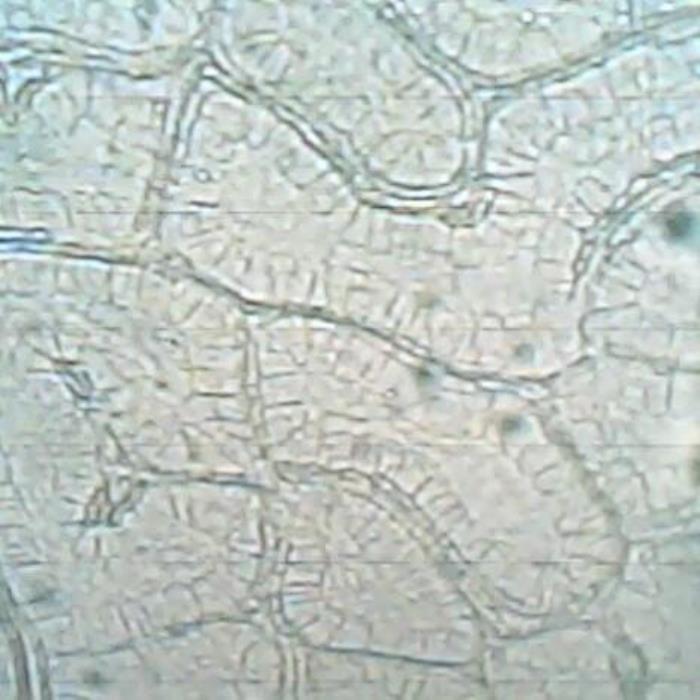
A) Surface view of leaf
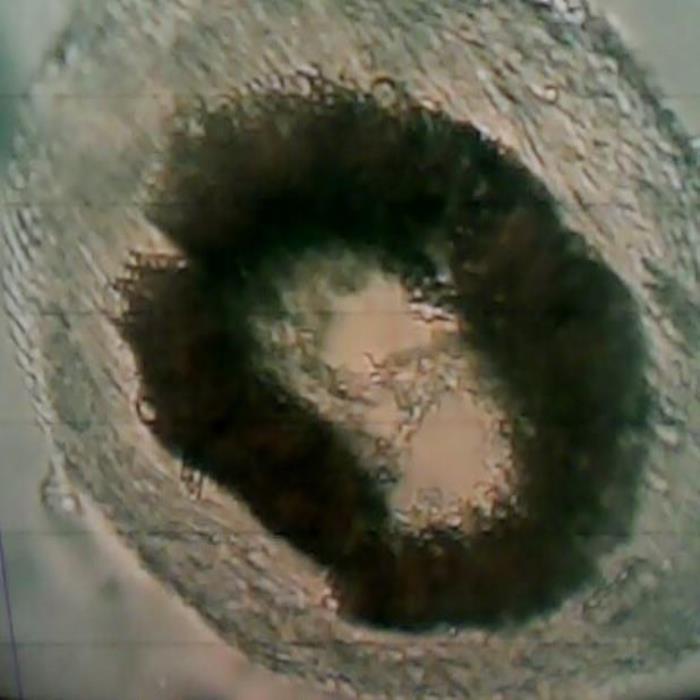
B) Oblique TS of stem
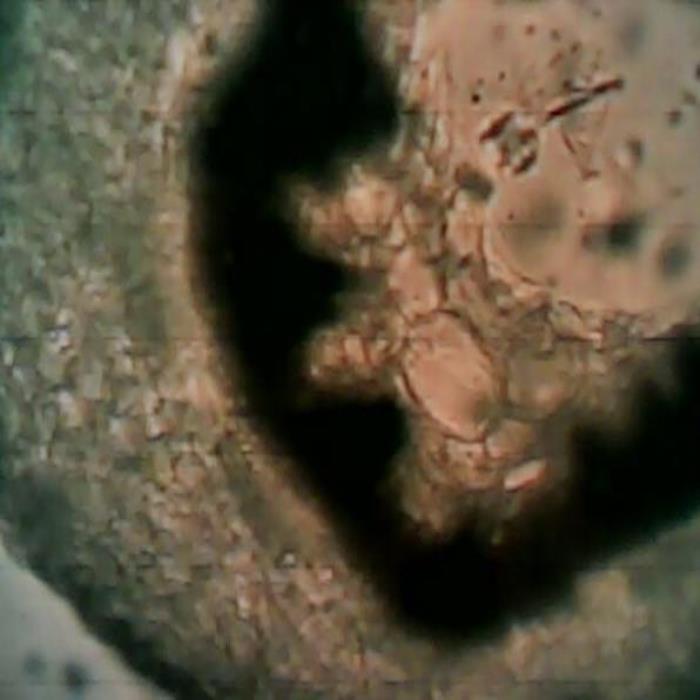
C) TS of stem
- A. A surface view of a portion of the leaf near the spongy mesophyll region showing the characteristic spongy mesophyll cells surrounding the vascular tissues which have similar sizes and they are arranged in an orderly manner forming one layer in each case.
- B. An oblique TS of the stem showing the general pattern of the different tissues of the stem: epidermis, cortex, vascular tissues (dark area) and pith with two lacunas (spaces) at the centre.
- C. A TS of a portion of the stem showing the epidermal cells that protrude in a half circle pattern followed by layers of rounded and compressed parenchyma cells, the vascular tissues (dark area) and pith with cells of irregular shapes and thick cell walls separated by lacuna (space) at the center.
Chemical constituents
The following constituents were isolated from the petroleum and alcoholic extracts of the whole plant: Hentriacontane, dotriacontanol, lupeol acetate, teraxasterol acetate, lupeol, taraxasterol, beta-sitosterol and gallic acid (Rastogi, 1995, Schmelzer ,2008). Rutin, quercetin, apigenin-7-glucoside and ellagic acid (Rastogi, 1993).
The following chemical studies have been carried out on the plant Euphorbia granulata (Quality Control methods, 1998; Evans, 1996; ZCHRTM unpublished work):
Physicochemical constants
Loss of weight in drying at 105°C : 9.30
Absolute alcohol solubility: 8.80
Water solubility : 13.60
Successive extractives (%)
Petroleum ether (60-80) °C : 2.25
Chloroform : 2.10
Absolute alcohol : 15.65
Water extractive : 22.10
Ash values (%)
Total ash : 10.17
Water soluble ash : 3.17
Acid insoluble ash (10% HCl) : 1.50
pH values (aqueous solution)
pH of 1% solution : 5.245-5.263
pH of 10% solution : 5.057-5.074
Elemental analyses
Ash values (British Pharmacopeia)
Assay and identification of element (AOAC International)
|
Apparatus |
AA-6800 Shimadzu-Flame method |
||||
|
Element |
Std. conc. µg/ml(ppm) |
Sample conc.mg/ml |
Sample absorbance |
Actual conc.mg/ml |
Actual conc. (%) |
|
Cr |
1, 2, 4 |
20 |
0.0904 |
0.10484 |
0.010484 |
|
Zn |
0.25, 0.5, 1 |
20 |
0.3082 |
0.014235 |
0.0014235 |
|
Cu |
1, 2, 4 |
20 |
0.0338 |
0.00931 |
0.000931 |
|
Fe |
1, 2, 4 |
20 |
1.2962 |
0.52144 |
0.052144 |
|
K |
1, 2, 4 |
1 |
0.8264 |
7.4367002 |
0.74367 |
|
Pb |
1, 2, 4 |
20 |
0.0061 |
0.0092 |
0.00092 |
|
Cd |
0.25, 0.5, 1 |
20 |
0.000 |
0.000 |
0.000 |
|
Ca |
5, 10, 20 |
1 |
0.0398 |
7.4665 |
0.74665 |
UV Spectral studies
|
Ultraviolet Spectrum (USP) |
||||
|
Apparatus |
Milton Roy Spectronic Genesys 5 Spectrophotometer - Milton Roy. |
|||
|
Sample conc. (mg / ml) |
Solvent |
λ max (nm) |
λ min (nm) |
Abs.( λ max - λ min) |
|
0.185833 |
Intestinal Fluid simulated without pancreatic pH=7.50.1 |
277 |
262 |
0.873 - 0.814 |
|
0.10025 |
Gastric Fluid simulated without pepsin pH =1.20.1 |
274 |
247 |
0.530 - 0.405 |
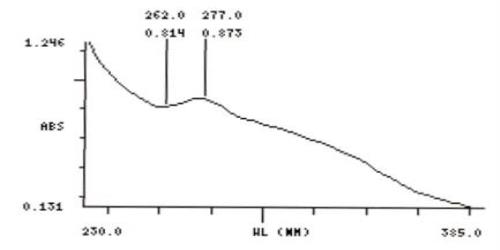
Intestinal Fluid simulated without pancreatic
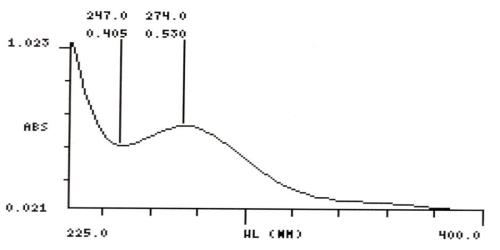
Gastric fluid simulated without pepsin
Chromatographic Studies
Thin layer chromatography (Wagner and Bladt, 1996)

A
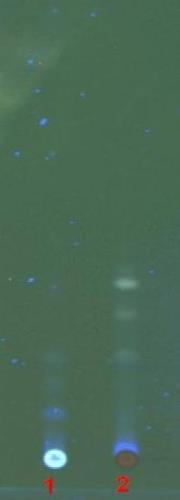
B
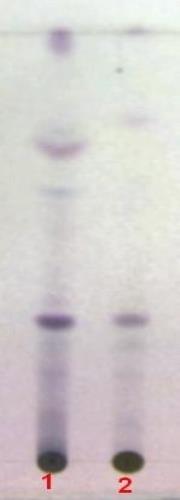
C
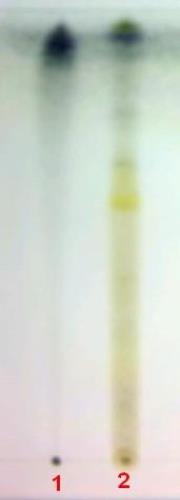
D
TLC fingerprint of Petroleum ether 60-80°C (track 1) and Methanol extract (track 2)
|
Mobile phase Fig. |
A&B |
: |
Toluene, ethyl acetate (93:7) |
|
|
C |
: |
Toluene, ethyl acetate (93:7) |
|
|
D |
: |
Ethyl acetate, methanol, water (100:13.5:10) |
|
Detection |
A |
: |
UV 254nm |
|
|
B |
: |
UV 366nm |
|
Derivatization |
C&D |
: |
Vanillin-Sulphuric acid- vis. |
Pharmacological and toxicological studies
The important pharmacological and toxicological activities of the plant Euphorbia granulata reported in various scientific journals are presented:
Fruit of Euphoria longana Lam. (longan) are consumed throughout Asia and are a major crop in Thailand. Nuchanart (2005) reportedly profiled the phytochemicals from 70% methanolic extract of peel, pulp, and seed tissues of longan fruit. The major components were identified as gallic acid, corilagin (an ellagitannin), and ellagic acid. A high-through-put reversed-phase HPLC method was developed to determine the content of these three compounds in different parts of the longan fruit and among different cultivars. The analyses showed that there was a large variation in the contents of gallic acid, corilagin, and ellagic acid in different plant tissues and cultivars. Seed contained the highest levels of the three phenolics, and pulp contained the lowest.
A pharmacological study showed efficacy of E. neriifolia latex as cytotoxic, antiarthritic and anti-inflammatory, leaf extract was an in-vitro antioxidant, wound healer and immunomodulatory (PapiyaBigoniya, 2008).
The extract of Euphorbia hirta L. and its component β-amyrin block most of the iNOS protein functions and NO induction, and could therefore be new selective NO inhibitors with great potential for treating arthritis inflammation (Mei-Fen Shih,2010).
The plant water and ethanol extracts (50 and 100 mg/kg) produced a time-dependent increase in urine output. Electrolyte excretion was also significantly affected by the plant extracts. The water extract increased the urine excretion of Na+, K+ and HCO3-. In contrast, the ethanol extract increased the excretion of HCO3- decreased the loss of K+ and had little effect on renal removal of Na+. Acetazolamide, also increased urine output and enhanced the excretion of Na+, K+ and HCO3-. The high-ceiling diuretic, furosemide, increased the renal excretion of Na+ and Cl-; but did not affect K+ and HCO3- loss. This study suggests that the active component(s) in the water extract of E. hirta leaf had similar diuretic spectrum to that of acetazolamide. These results validate the traditional use of E. hirta as a diuretic agent by the Swahilis and Sukumas (Johnson, 1999). The stilbene, piceatannol, isolated from E. lagascae seeds was screened for its antileishmanial activity against promastigotes as an extracellular form of Leishmaniadonovani, Leishmaniainfantum and Leishmania major, and amastigotes of Leishmania donovani as an intracellular form. Pentostan (sodium stibogluconate), the first line clinical drug, was used as a standard reference. Piceatannol was moderately active against the extracellular forms of the three tested Leishmania species, and more active than the reference compound against the intracellular form of Leishmania donovani (Duarte, 2008).
The results on the pharmacological and Toxicological studies carried out on aqueous extract of Euphorbia granulata at ZCHRTM Lab. (Derelanko 2002; Han, 2003) have been summarized below:
|
ACTIVITY |
RESULTS |
|||
|
Strong |
Moderate |
Mild |
Negative |
|
|
Analgesic (Writhing + Tail flick) |
|
|
|
√ |
|
Anti-inflammatory (Paw & ear edema) |
|
|
|
√ |
|
Antidepressant |
√ |
|
|
|
|
Anticonvulsant |
|
|
|
√ |
|
Hepato-protective activity |
|
√ |
|
|
|
Diuretic activity |
|
|
|
√ |
|
Antithrombotic effect |
|
|
√ |
|
|
Biochemical studies (TP, AST, ALT ↓) |
√ |
|
|
|
|
Hematological studies |
|
|
|
√ |
|
Effect on right rat atria |
|
|
√ |
|
|
Blood pressure and heart rate |
|
|
√ |
|
|
Effect on rat fundus |
√ |
|
|
|
|
Effect on Guinea pig ileum |
|
|
√ |
|
|
Effect on Guinea pig tracheal chain |
|
|
|
√ |
|
Effect on detrusor muscle (Urine bladder) |
|
|
√ |
|
|
Acute toxicity on mice |
|
|
|
√ |
|
Locomotor activity test |
|
|
|
√ |
| Motor co-ordination (grip strength & motor activity | √ | |||
|
Rectal temperature |
|
|
|
√ |
|
Body weight |
|
|
|
√ |
|
Mortality |
|
|
|
√ |
Summary of the results
The biochemical study showed that the Alanine transaminase (ALT) was mildly decreased; the Aspartate transferase (AST) and the Total protein (TP) significantly decreased when compared to the control values indicating hepato-protective activity.
Antidepressant activity carried out on the plant extract showed significant reduction in immobility time.
The plant extract has a very mild antithrombotic effect in vivo, which may be due to the fibrinolytic activity. The extract produced significant effect on the isolated rat fundus tissue contraction activity in the water bath.
The plant extract has digestive and carminative nature in relieving constipation.
The extract has mild activity of kidney stone expulsion.
The extract showed cardio-tonic effect in vitro. There were no toxic signs and symptoms at the dose 10g/kg-1 p.o. however it has sedative effect checked by locomotor and Rota rod activities.
No change in body weight and no death after one week of treatment.
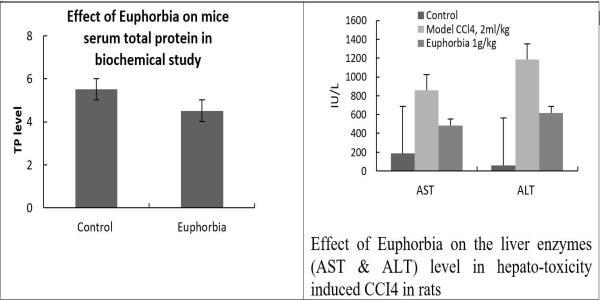
Effect on serum total protein
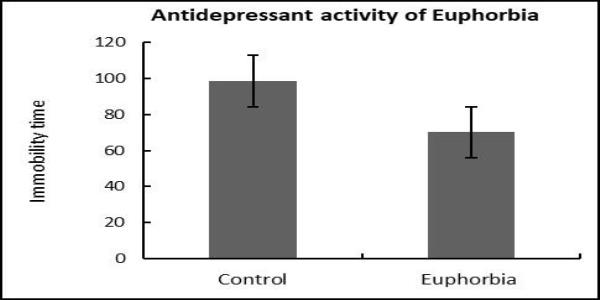
Antidepressant effect

The effect on isolated rat fundus tissue contraction
Antimicrobial studies
The aqueous extract of the whole plant was tested against Mycobacterium smegmatis, C. tropicalis, different strains of Staphylococcus aureus (Including ATCC 257) as well as Methicillin Resistant Staphylococcus aureus, different strains of E. coli (Including ATCC UN 109), different strains of ESBL-producing K. pneumonia, E. coli, Pseudomonas aeruginosa. The extract had a weak antibacterial activity against Mycobacterium smegmatis only.
References
- A.R.Western. The flora of the United Arab Emirates – an introduction, UAE University Press, p.95, 1989.
- Duarte N, Kayser O, Abreu P, Ferreira MJ. Antileishmaniac activity of piceatannol isolated from Euphorbia lagascae seeds. Phytother Res. Apr. 2008; 22:455-7.
- Flora of Pakistan; www.efloras.org
- G.H. Schmelzer & A. Gurib-Fakim. Plant Resources of Tropical Africa 11 (1).Medicinal Plants 1. Wageningen, Netherlands.2008. p.264
- Hazim S Daoud. Flora of Kuwait, Vol.1. KPI Publ. London, 1985.
- J.R.I. Wood. A handbook for the Yemen Flora, Royal Botanic Gardens, Kew, London, p.181, 1997.
- James P. Mandaville. Flora of Eastern Saudi Arabia. The Gresham Press, London, p.203, 1990.
- Johnson PB, Abdurahman EM, Tiam EA, Abdu-Aguye I, Hussaini IM. Euphorbia hirta leaf extracts increase urine output and electrolytes in rats. J Ethnopharmacol. Apr.1999, 65:63-9.
- Jonbloed, M. V., Feulner, G. R., Boer, B. & Western, A. R. (2003). The comprehensive Guide to the Wild Flowers of the United Arab Emirates, Erwda, Abu Dhabi, U.A.E.
- Mei-Fen Shih, Yih-Dih Cheng, Chia-Rui Shen and Jong-Yuh Cherng A molecular pharmacology study into the anti-inflammatory actions of Euphorbia hirta L. on the LPS-induced RAW 264.7 cells through selective iNOS protein inhibition. Journal of Natural Medicines, Vol. 3 July, 2010, 64:330-335
- Nuchanart Rangkadilok, Luksamee Worasuttayangkurn, Richard N. Bennett, and Jutamaad SatayavivadIdentification and Quantification of Polyphenolic Compounds in Longan (Euphoria longana Lam.) Fruit J. Agric. Food Chem., 2005, 53: 1387-1392.
- Papiya Bigoniya and A.C. Rana A Comprehensive Phyto-pharmacological Review of Euphorbia neriifolia Linn. J. aPharmacognosy Reviews, Vol: 2 July 2008 4:57-66
- Rastogi & Mehrotra, Compendium of Indian medicinal plants : vol. 3, PID, New Delhi,1993, p.281
- Rastogi & Mehrotra, Compendium of Indian medicinal plants : vol. 4, PID, New Delhi,1995, p.309.
- Schmelzer, G.H., 2008. Euphorbia granulata Forssk. In: Schmelzer, G.H. & Gurib-Fakim, A. (Editors). PROTA 11(1): Medicinal plants 1, PROTA, Wageningen, Netherlands.
